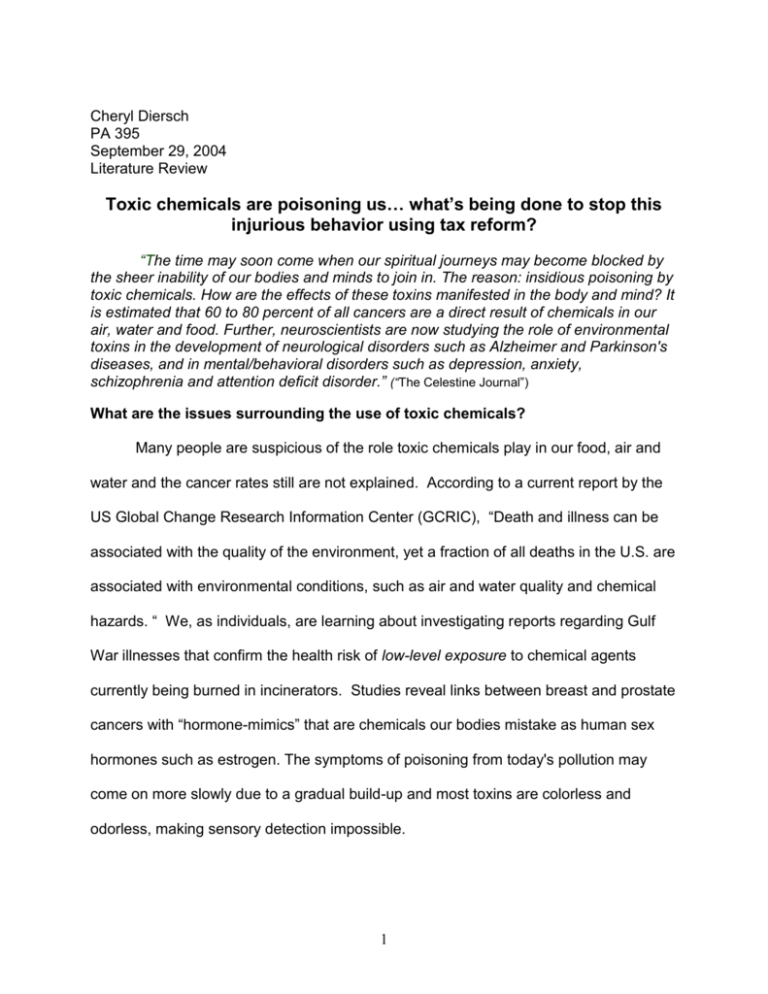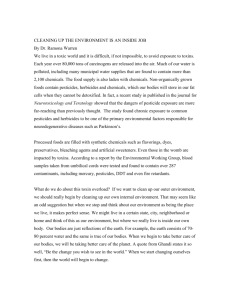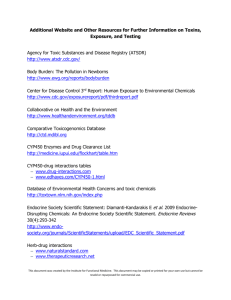Toxic chemicals are poisoning us, What`s being done to stop this
advertisement

Cheryl Diersch PA 395 September 29, 2004 Literature Review Toxic chemicals are poisoning us… what’s being done to stop this injurious behavior using tax reform? “The time may soon come when our spiritual journeys may become blocked by the sheer inability of our bodies and minds to join in. The reason: insidious poisoning by toxic chemicals. How are the effects of these toxins manifested in the body and mind? It is estimated that 60 to 80 percent of all cancers are a direct result of chemicals in our air, water and food. Further, neuroscientists are now studying the role of environmental toxins in the development of neurological disorders such as Alzheimer and Parkinson's diseases, and in mental/behavioral disorders such as depression, anxiety, schizophrenia and attention deficit disorder.” (“The Celestine Journal”) What are the issues surrounding the use of toxic chemicals? Many people are suspicious of the role toxic chemicals play in our food, air and water and the cancer rates still are not explained. According to a current report by the US Global Change Research Information Center (GCRIC), “Death and illness can be associated with the quality of the environment, yet a fraction of all deaths in the U.S. are associated with environmental conditions, such as air and water quality and chemical hazards. “ We, as individuals, are learning about investigating reports regarding Gulf War illnesses that confirm the health risk of low-level exposure to chemical agents currently being burned in incinerators. Studies reveal links between breast and prostate cancers with “hormone-mimics” that are chemicals our bodies mistake as human sex hormones such as estrogen. The symptoms of poisoning from today's pollution may come on more slowly due to a gradual build-up and most toxins are colorless and odorless, making sensory detection impossible. 1 The U. S. Global Change Research Information Center (GCRIC) reports regularly about the consequences of toxic chemicals on nature and implications of environmental change. In a current GCRIC journal titled “The Environment Since 1970” reports on global health, nuclear waste, urban air pollution, waste disposal and materials use. Following is an excerpt from the journal… “As many people worry less about survival and acute and catastrophic conditions, they think more about chronic exposures and rare illnesses. Remarkably environmental pollutants in air, water, soil, and food and how these may be changing know little in any country about actual and cumulative human exposures.” Kim Nelson, head of the Environmental Protection Agency (EPA) Office of the Environmental Information said, “This ignorance bedevils ongoing debates about chlorinated compounds, breast and other cancers, electromagnetic fields, and a host of other concerns.” Most agree that clean lakes, rivers and air are essential for environmental health as well as critical for the health of mankind. In 1989 the EPA’s National Report on Toxic Release Inventory, announced that 1.9 billion pounds of chemical were dumped into the water systems of our nation and that 2.4 billion pounds of chemicals were released into the atmosphere. The total chemical bombardment on the environment was estimated at 5.7 billion pounds for one year, not to mention almost 50 million pounds of toxic chemicals buried in our landfills, rivers and lakes. If the use of chemicals continues to be ignored, emissions into the air and water will grow and affect the environment beyond nature’s threshold as evidence in “Brownfields” or “Super fields.” However, nothing is changing with the use of chemicals. “It doesn’t take a giant leap of logic to realize that we could soon be in such a state of toxic poisoning that we would be unable to ‘problem-solve’ our way out.” (CJ) 2 Simply adding up tons of different chemical pollutants is like comparing apples to oranges and the sheer volume of it all is staggering. There are tens of thousands of chemicals being used today. These chemicals are injurious to the environment and our health during manufacturing, transport, and in the disposal of waste from these hazardous chemicals. In the 1990 Clean Air Act Amendments passed by Congress identified 189 pollutants as "hazardous air pollutants," but today there are still no emission fees on these pollutants. Implementing tax reform, like all reforms, will be gradual and slow. Yes, banning the use of hazardous chemicals will solve a number of environmental problems and we can start by setting emission quotas on the polluting substances. However, it will take heightened public awareness through political action to see global, regional and local changes. Quotas, bans and standards have to be agreed upon at a high level of governance and bringing politicians, corporations, individuals and legislature together is often arduous and difficult, especially when voting is crucial. The EPA originally designed a report back in the 80’s to inform communities about toxic substances released by their industries as a "right to know program" yet today it fails on its integrity due to self-monitoring. In June 2004, the Wall Street Journal reported that environmental groups questioned the accuracy of an annual Environmental Protection Agency study on toxic pollutants. The Washington-based Environmental Integrity Project said, “measurements taken by state agencies in Texas showed that carcinogenic chemicals such as benzene and butadiene given off by oil refineries and chemical plants may be four to five times the levels reported by the EPA.” "This happens because most pollution is estimated and not monitored," said Kelly Haragan, a lawyer for the Environmental Integrity Project. She said, “the 15-year- 3 old Toxic Release Inventory Report run by the EPA allows companies to file estimates of their release of toxic pollutants instead of using data from monitoring instruments.” We have a high degree of uncertainty inherent in many of our governmental systems, reports, studies and chemicals and since there is a reasonable certainty of harm that exists, decisions need to err on the side of protection. My review shows the necessity for change in our current rationales to regulate our health and environment. Jurisdictions around the world, including the whole of the European Union, are using precaution as their underlying basis for regulating the environment. British Columbia has established variable environmental fees assessed on the basis of potential environmental harm. “Precautionary Principle” is the best balance for environment, health and economic concerns. What is the green tax status in the United States and Vermont? My research started on the Internet. When it was impossible to find any state data that talked about taxes, resulting from harmful toxic chemical use, I decided to read the assigned book “Tax Shift,” and three pages from the back, in the paragraph titled “Toxic Pollution Taxes,” it clearly states, “….data on economic costs of toxic emissions essentially nonexistent.” Durning and Bauman recommends a tax rate average of $16,000 per ton ($8.00 per pound) to depend on pollutant, therefore it will vary widely. Their research on farm chemical taxes produces the same—“data on economic costs of farm chemicals sparse to nonexistent.” And again their tax recommendation on pesticides averages $16,000 per ton, varying widely depending on pesticide.” The silver lining is, Vermont generates less hazardous waste compared to other states, due to a very small industrial sector. My research found new areas for 4 environmental taxation are emerging in Vermont like the $75.00 product fee that companies pay in order to retail their products containing specific ingredients, for example anti-bacterial soaps. Janet Milne writes, “Changes will require political will.” When it comes to change in our environment, the change will come from a social change movement, from the outside —not from DC, as we saw with the womens’ movement. Is the grass greener on the other side of the globe? “As much as 95% of the European environmental tax revenue comes from the energy and transport sector and less than 5% comes from taxes on other items such as on emissions, chemical substances, products, waste and natural resources” writes the European Environment Agency (EEA). Several European countries are exploring policies for industry product responsibility, agricultural inputs (fertilizers & pesticides), and chemicals such as solvents, PVC, phthalates, raw materials, ground water, aviation and tourism. While some of these are more of a regulatory approach to addressing environmental externalities, they have some link to environmental tax shift policies. This points toward the “polluter pays” theory. Pesticide taxes are already implemented in 5 European states: Belgium (not agriculture), Denmark, Finland, Norway and Sweden. Taxing pesticides: includes disinfectants, fungicides, herbicides and insecticides. Taxing is based on the following three concepts: The quantitative active ingredient, The standardized area dose or the Retail price. 5 The EEA reports that with taxes on fertilizers and pesticides it appears to have contributed to reductions in the use of these products. In Denmark, pesticide use fell by 10-13%, in Denmark and in Austria reduction with use of fertilizers is estimated at about 2.5%. Yet, these are not entirely concrete because they are based on ex post ex post evaluations. Having said this, the existing environmental taxes in Europe seem to “provide incentives to economise the tax base, thus contributing to the reduction of environmentally harmful emissions, products and activities,” as summarized by the EEG. It’s difficult to assess the tax itself and single out the impact of the tax on most product taxes such as batteries, pesticides and packaging because they are so much a part of a policy package. In conclusion, greater Non-governmental Organization (NGO) activism aimed at agriculture, pharmaceuticals, energy, mining, fisheries, aquaculture, in short any and every sector of the economy the NGOs find objectionable, is the next step to pursue. Since the 70’s we have been talking about the impact of chemical use in production on the environment and our health. Here we stand today in a new millennium, with no changes in behavior, only more passionate questions. What will it take for there to be urgency to motivate change? 6 Bibliography Alan Thein Durning & Yoram Bauman. Northwest Environment Watch - Tax Shift. 1998 Seattle, WA 98101-2130 Hausauer, Brenda. Tax Reform that Agrees with Vermont. Vermont Fair Tax Coalition, March 1999. Environmental Taxes: recent developments in tools for integration. European Environment Agency, Copenhagen, Denmark. November 2000. Janet Milne et al., editors, Critical Issues In Environmental Taxation: International And Comparative Perspectives, Vol.1 (Richmond Tax & Law 2003, pp. 1-26. “The Celestine Journal", and is reprinted with permission from Satori Publishing, P.O. Box 360988, Hoover, AL 35236. The Environment Since 1970, 1995. Jesse Ausubel, David Victor, and Iddo Wernik. http://www.gcrio.org/CONSEQUENCES/fall95/envir.html Toxic Released Increased in 2002, study says, 6/23/04 and Texas Air Toxins Raise Doubts Over EPA, 6/23/04 Kelly Haragan, Environmental Integrity Project. http://www.equaljusticeworks.org/news/ http://www.cbo.gov/ http://www.ilsr.org/ecotax/greentax.html 7







